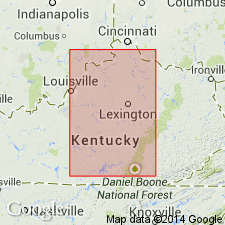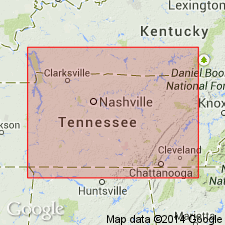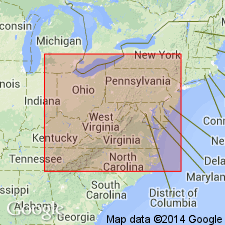
- Usage in publication:
-
- Dowelltown formation
- Modifications:
-
- Named
- Dominant lithology:
-
- Shale
- AAPG geologic province:
-
- Appalachian basin
Summary:
In the type area of DeKalb Co. and adjacent territory, the Dowelltown formation (new name) consists of lower and upper members, each with a lower bed of fissile black shale and an upper bed with interbedded layers of gray and black shale. Near the crest of Nashville Dome, the formation is a poorly fissile soft dull-black shale that shows a blending of the black and gray shale elements. Lower member pinches out and is represented at Nashville only by a foot of sandstone. A layer of sandstone, which is correlated with the Hardin sandstone occurs at base of Dowelltown at Celina. Thickness varies: 22 to 29 ft in the type area; 8 to 12 ft in Macon and Clay Cos.; 15 to 19 ft in Sumner Co. Lies between Trousdale formation below and Gassaway shales (new) above and is basal part of the Chattanooga in most of central TN. Age is Devonian.
Source: GNU records (USGS DDS-6; Reston GNULEX).

- Usage in publication:
-
- Dowelltown member*
- Modifications:
-
- Revised
- AAPG geologic province:
-
- Appalachian basin
Summary:
In this report, Dowelltown is considered a member of the Chattanooga shale. Underlies Gassaway member and in some areas overlies Hardin sandstone member. Where well developed, it is between 10 and 17.5 ft thick and consists of two persistent units. The lower one is predominantly black shale, and the upper is primarily a grayish mudstone, near the top of which is a bentonite bed about 0.1 ft thick. On the west flank of the Cincinnati anticline, Dowelltown is commonly a sandy black shale as much as 17 ft thick. Unit wedges out in Sequatchie Valley of eastern TN and has not been recognized in south-central TN or north-central AL.
Source: GNU records (USGS DDS-6; Reston GNULEX).

- Usage in publication:
-
- Dowelltown Member*
- Modifications:
-
- Overview
- AAPG geologic province:
-
- Appalachian basin
Summary:
Chattanooga Shale in TN and northern AL is the distal fringe of the black gas shales in the southwestern Appalachian basin. In central TN, where the unit ranges in thickness from a featheredge to more than 35 ft it is divided into the Dowelltown Member below and the Gassaway Member above. The Dowelltown consists of a lower black shale, the Rhinestreet Shale Bed (6 ft), and an upper unit of interbedded medium- and dark-gray shale, the undivided Angola and Hanover Shales (9 ft) at Sligo Bridge, DeKalb Co. The Center Hill Ash Bed occurs in the upper part of the Dowelltown. In south-central KY, the Dowelltown is absent. The Chattanooga thickens northeastward and reaches more than 1,000 ft in northeast TN and southwest VA, but there the Gassaway and Dowelltown are not recognized as separate lithostratigraphic units.
Source: GNU records (USGS DDS-6; Reston GNULEX).
For more information, please contact Nancy Stamm, Geologic Names Committee Secretary.
Asterisk (*) indicates published by U.S. Geological Survey authors.
"No current usage" (†) implies that a name has been abandoned or has fallen into disuse. Former usage and, if known, replacement name given in parentheses ( ).
Slash (/) indicates name conflicts with nomenclatural guidelines (CSN, 1933; ACSN, 1961, 1970; NACSN, 1983, 2005, 2021). May be explained within brackets ([ ]).

